Working with classic machinery
Posted by Chris Graham on 2nd February 2024
Scott Lambert visits Mark Ray’s Cambridgeshire farm to have a chat about the pros and cons of working with classic machinery.
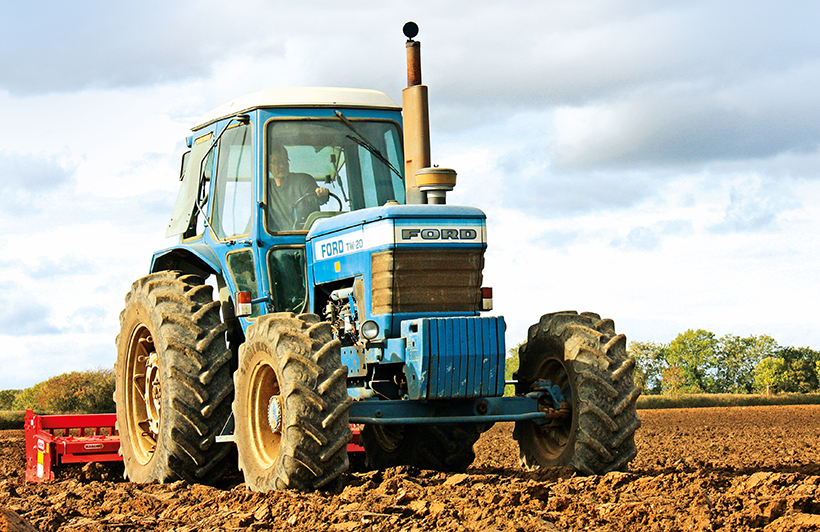
Working with classic machinery: Mark Ray’s 1979 Ford TW-20 was purchased in 2000 and is seen here with a Maschio Gaspardo Daino DS three-metre power harrow.
Close to the south-west corner of The Fens lies the picturesque village of Broughton, and it’s here, in 1921, that Harry Ray moved from Northamptonshire when he purchased Illings Farm, which was then largely grassland.
It was well suited to Harry’s dairy herd, which he walked the 21 miles or so from Cotterstock with the help of his wife and three sons, but he also rented another farm in the village, before later giving it up to concentrate on his own land.
The Rays are the oldest established farming family in Broughton and encourage villagers to enjoy their land through a small number of public footpaths and an extensive network of permissive footpaths that are open to the public every day except Christmas Day. The permissive paths are closed one full day every year to ensure they don’t become permanent rights of way.
Illings Farm is, by today’s standards, a very small enterprise at 39 hectares (96.4 acres). The land is predominantly heavy clay, suited to growing milling wheat (Skyfall and Zyatt) for bread making, and either oilseed rape, winter beans, or spring oats as a break crop. The farm once produced barley, potatoes, and sugar beet.
Nine acres of ancient ridge and furrow grassland are also part of the composition, having sustained cattle, pigs, and hens over the years. A milk round was also once an important source of income for the farming business, in addition to the arable work. John, Harry’s grandson, now in his 80s, still does the milk round two days a week!
Today, the grassland is let out for horse grazing, and Mark, Harry’s great-grandson, works part time as an accountant when he’s not on the farm.

This 1984 Track Marshall TM 155 works extensively with a 2.5-metre Cousins V-Form after harvest.
“We aim to integrate modern farming techniques with caring for the wildlife, alongside providing access for the public,” he told me. “We have retained a large number of hedges and trees on the farm, and have relatively small fields, so it is not your typical East Anglian ‘wheat prairie’ farm!”
That is one of the first things that strikes you about Illings Farm – it is very different to the farms that are just a stone’s throw away. It has retained the charm of a bygone era while looking forward to the future – farming for the good of the land, its produce, and the environment.
With grass margins and an extensive network of hedges and mature trees around the fields, biodiversity is a key element of farming operations, encouraging pollination and using nature to keep pests in check wherever possible.
In addition to this, Mark and John rejuvenated an old pond adjacent to the farmyard and planted a small wood to celebrate the millennium. This is now well established.
Hired help
John is retired, but still helps around the farm at busy times, but with such a small acreage, Mark can undertake most jobs on his own, using a fleet of classic machines that has been accumulated over the years.
“Modern-day machinery is very expensive to buy and maintain, so we use a local contractor, WS Campbell & Son, to do our combining and primary cultivations, and then undertake sub-soiling, mole draining, power harrowing, drilling, rolling, spraying, and fertiliser spreading ourselves.”
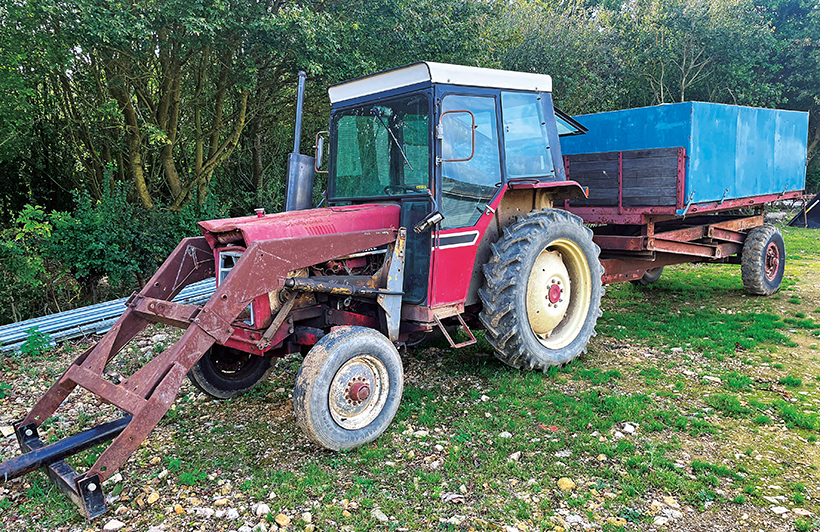
The arrival of a JCB Loadall 528S has seen this 1980 IH 484 fall down the pecking order.
Over the years Ford tractors have played a major role at Illings Farm, with John and his father, Alfred, running a Fordson Major and Ford 4000s before Mark’s involvement in the business.
In the three decades leading up to 2020, a varied selection of machinery was purchased to fulfil the Rays’ needs, and of this the following remain – starting with a tractor not seen much today, the International 484.
Built in Doncaster from 1977-’81, just 5,320 examples were produced – making it one of the rarer models in the range. Producing 52hp from a German-built three-cylinder engine, the Rays considered the tractor to be a useful addition to the farm because it was fitted with a loader when they purchased it in the mid ’90s.
When a small baler was used to process the straw behind the combine, the 1980 IH 484 was used to stack the bales onto trailers, as well as handling fertiliser and seed. With the advent of big balers and larger bags to lift, the little tractor no longer had the capacity or reach to cope and is now retired, thanks to the purchase of a JCB Loadall 528S in 2019.
Bought in 2000, the farm’s largest tractor is a 1979 Ford TW-20 that was supplied new by Ernest Doe & Sons Ltd. Thanks to its output of 153hp, it was added to the fleet primarily with ploughing in mind, but is used today with a disc harrow, power harrow, and for any cultivating that Mark undertakes himself.
It has proved to be a good tractor, but had to be fitted with a new engine in 2005 when the original went porous. It has had a replacement clutch since Mark has owned it, but it is a tidy example of a desirable classic, now with 6,304 hours under its belt.

Weighing 10,341kg, the TM 155 exerts pressure on the ground of just 8.4psi.
Continuing the farm’s association with the blue oval is a 1980 Ford 7700, bought in 2003 to do the jobs not undertaken by the TW-20 – such as drilling, rolling, spraying, and fertiliser spreading.
It too suffered from a porous engine, forcing a replacement, but the writing was already on the wall for the 97hp tractor, predominantly due to implement upgrades.
When the drill, fertiliser spreader, and sprayer that had all been used with the 7700 made way for larger and more up-to-date examples, the tractor no longer had the lift capacity, hydraulic capability, or electrical connections to run them.
Going green
Mark had, in effect, forced himself into a corner. The TW-20 had the lift capacity for the larger implements, but it too was lacking in the type of electronics required to run the control boxes that are used in conjunction with modern sprayers and spreaders.
This meant the arrival of another tractor, but there was something else on Mark’s shopping list before that, enabling him to make progress when once he would have been unable to!
With heavy clay comes problems not necessarily faced by farmers living a few miles away in The Fens – at least not to the same extent. Panning is an issue that can be overcome by using the right implement at the right time, and although Mark recognises that nature plays a significant part in improving soil structure, he knows it needs a helping hand.

Now leading a more sedate life, the 1980 Ford 7700 was once the farm’s prime mover.
His weapon of choice in loosening and aerating the soil is a Cousins V-Form, supplied by G&J Peck Ltd, but using such a machine in heavy clay requires a tractor with plenty of power and, above all else, traction. Mark purchased a 2.5-metre, medium-duty model, with five tines and a 24in-diameter toothed packer, and despite Cousins’ literature not stating the horsepower requirement, he realised that the implement would be too much for the TW-20.
The answer to this is a 1984 Track Marshall TM 155, powered by a Perkins T6.3544 engine rated at 155hp and producing 515Nm of torque at 1,600rpm. The crawler tips the scales at 10,341kg, but has a ground pressure of just 8.4psi.
This helps reduce compaction, and the length of track on the ground means that maximum drawbar pull is 11,322kg – making the TM 155 ideal for pulling the V-Form and a mole drainer.
It arrived on the farm in 2014 from Track Marshall specialist Robert H Crawford & Son, in Frithville, Lincolnshire, and has proved to be a useful addition to the fleet. It’s showing a few battle scars but has been very reliable, save for a failed track tension adjuster seal that necessitated a journey back to Crawfords for repair.
Just two years later, the Ford 7700 was relieved of its main duties when a 1996 John Deere was purchased. This left the Ford, which has racked up more than 11,000 hours, free to top the meadows and grass margins – jobs that are much more within its capabilities.
The weather has a significant role to play in any farming operation, and with heavy land like that of Illings Farm, as well as the contentious issue of Black-grass control, there’s pressure to prepare the land for drilling and get crops planted before Mother Nature chooses to close the window of opportunity.

Like many of the implements on the farm, this power harrow is less than 10 years old and is stored undercover whenever possible.
Beating the weather
2023 is a case in point, as when these photographs were taken, Mark was preparing to drill shortly after, but the rain set in and now he has abandoned his plans in favour of spring drilling. As much as the TW-20 and TM 155 meet his needs, he wonders if trading them both for a larger, more modern machine would help operations become more efficient and enable him to beat the weather.
A New Holland TM190 would, Mark feels, be the perfect fit for the farm – due to its power output and versatility. These tractors do not have the best reputation, due to reliability problems stemming from an oil cooler that was too small. Unable to cope under heavy load, the result would be the rear end overheating and causing the powershift transmission to fail.
New Holland instigated a recall programme, sorting the problem, but the reputation of the long-wheelbase TM models had been tarnished. Buy a later example, once all the creases had been ironed out, and you have a tractor that’s cheap horsepower with enviable performance. This is why Mark sees a 20-year-old TM190 as a sensible purchase.
With tractors like the John Deere 6600 (and the TM190) come powershift transmissions, electronic linkage control, and numerous other operator-friendly functions that require specialist equipment to help diagnose problems and repair, so Mark entrusts servicing and major repairs to local agricultural engineers, but minor repairs are undertaken on the farm.
Newer equipment means more specialist interventions, resulting in greater expenditure, so any future machinery purchases require careful consideration. A 39-hectare farm cannot justify serious outlay on more modern equipment, but with that comes productivity and the ability to meet time-
sensitive deadlines. It’s a balancing act!
Whatever the future holds for Illings Farm, it’s almost certain that there’ll be a blue presence – just as there always has been!
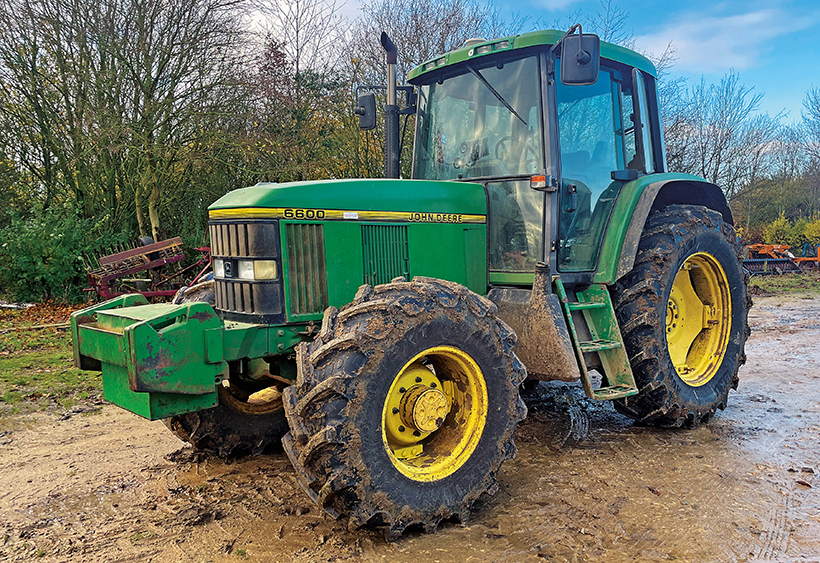
A desirable, modern classic; this 1996 John Deere 6600 was supplied by Hassingham-based used agricultural machinery specialist. J Murrell.
The machinery used will play a definitive role, but doing what’s best for the land and for the benefit of wildlife will go hand in hand as Mark strives to meet the demands of economic viability and legislation.
Although the livestock may be long gone, and Mark has another source of income, farming is still very much a way of life for him. It’s a passion that goes back generations, and one that he is keen to share with those that live around the farm – encouraging them to enjoy the countryside and observe the changes throughout the seasons, of both the wildlife and the fields.
USEFUL CONTACTS
Robert H Crawford & Son
Frithville, Lincolnshire
Tel: 01205 750367
rhcrawford.com
Ernest Doe & Sons Ltd
Littleport, Cambridgeshire
Tel: 01353 860761
ernestdoe.com
J Murrell
Hassingham, Norfolk
Tel: 01603 712222
jmurrell.co.uk
G&J Peck Ltd
Ramsey St. Marys, Cambridgeshire
Tel: 01733 844642
peck.co.uk
This feature comes from the latest issue of Tractor & Machinery, and you can get a money-saving subscription to this magazine simply by clicking HERE
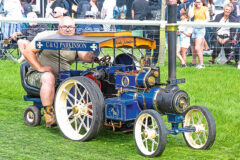
Previous Post
Fantastic miniature steam engines at the Driffield Steam Fair
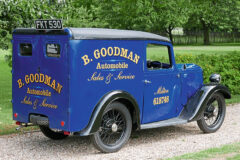
Next Post
Dinky-sized Austin Seven vans



